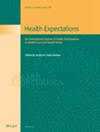Ripple Effects Mapping: Evaluating Multilevel Perspectives and Impacts of a Statewide Community–Academic Partnership Network on Covid-19 Health Disparities
Abstract
Introduction
Community–academic partnerships played an important role in addressing Covid-19-related health disparities in historically marginalised groups such as racial ethnic minorities and low-income and rural communities in the pandemic. Part of the federal response involved establishing regional community academic networks that engaged highly impacted communities in health disparities research. The statewide Share, Trust, Organize, Partner COVID-19 California Alliance (STOP COVID-19 CA) network was part of the federal response.
Methods
In spring 2024, ripple effects mapping (REM), a participatory action research method, was used to conduct an evaluation of the impact of the STOP COVID-19 network on the capacity of community–academic partnerships to carry out Covid-19-related health disparities research. This method uses group interviews to capture direct and indirect outcomes, that is, ripples, of community-based programmes. Short-, medium- and long-term changes and conditions related to community–academic partnerships in the statewide network were mapped onto the spheres of influence of the social ecological model.
Results
A total of 24 participants took part in one of three REM sessions. Community and academic partners were represented in all sessions, and most had been involved in community-engaged research for 3 to 10+ years. Most identified as female, Hispanic/Latino, and between the ages of 40 and 49. Qualitative analysis of sessions indicated that most changes occurred at the individual and interpersonal levels and involved medium-term changes (e.g., increased capacity to partner in research and shared understanding). Neighbourhood- or community-level changes included identification of culturally and linguistically responsive intervention and dissemination efforts (e.g., promotora model). Policy and built environment conditions reveal the inequities in higher education and the need for structural-level changes to university infrastructure and grant administration.
Conclusion
Most outcomes were observed at the individual and interpersonal (group) levels and involved primarily medium-term changes. However, the network itself served as a platform to discuss the need for structural-level changes within university infrastructure to facilitate community-engaged scholarship. Such networks have the potential to facilitate capacity building for community–academic partnerships to collaborate in health disparities research that can generate evidence to move forward public health policy change.
Patient or Public Contribution
Community partners, including grassroots leaders and staff of community-based organisations, were involved in the development of the research questions, the design of the study, and data collection, analysis and interpretation of the findings. Community partners also contributed to manuscript development.


 求助内容:
求助内容: 应助结果提醒方式:
应助结果提醒方式:


